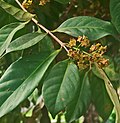Bay leaf
Bay leaf refers to the aromatic leaves of several plants used in cooking. These leaves come from a variety of species, including: Laurus nobilis (bay laurel), Syzygium polyanthum (Indonesian bay leaf), Cinnamomum tamala (Indian bay leaf), and Umbellularia californica (California bay leaf).
Description[edit]
Bay leaves are typically used in their dried form as a flavoring in a variety of dishes, and are an integral part of the bouquet garni, a bundle of aromatic herbs used in traditional French cooking. The leaves are most often used whole and removed before serving. In addition to their culinary uses, bay leaves have been used in traditional medicine and have symbolic significance in some cultures.
Species[edit]
Laurus nobilis[edit]
Laurus nobilis, or bay laurel, is a tree native to the Mediterranean region. It is the species whose leaves are most commonly referred to as "bay leaves". The leaves are shiny, dark green, and can be up to 3 inches long.
Syzygium polyanthum[edit]
Syzygium polyanthum, also known as Indonesian bay leaf or daun salam, is a species of tree native to Indonesia. Its leaves are used in many Indonesian dishes.
Cinnamomum tamala[edit]
Cinnamomum tamala, or Indian bay leaf, is a tree native to India and Nepal. Its leaves have a flavor similar to cinnamon and are used in Indian cooking.
Umbellularia californica[edit]
Umbellularia californica, or California bay leaf, is a tree native to coastal forests of California and slightly into Oregon. Its leaves have a stronger flavor than those of the bay laurel.
Uses[edit]
Bay leaves are used in a wide variety of dishes, from soups and stews to meat and vegetable dishes. The leaves are often used in slow-cooked dishes, as they release their flavor slowly.
Health Benefits[edit]
Bay leaves have been used in traditional medicine for their supposed health benefits. They are believed to have anti-inflammatory, antioxidant, and digestive properties.
See Also[edit]
-
Bay Leaves
-
Indian bay leaf - tejpatta - indisches Lorbeerblatt
-
Syzygium polyanthum
Ad. Transform your life with W8MD's Budget GLP-1 injections from $75


W8MD offers a medical weight loss program to lose weight in Philadelphia. Our physician-supervised medical weight loss provides:
- Weight loss injections in NYC (generic and brand names):
- Zepbound / Mounjaro, Wegovy / Ozempic, Saxenda
- Most insurances accepted or discounted self-pay rates. We will obtain insurance prior authorizations if needed.
- Generic GLP1 weight loss injections from $75 for the starting dose.
- Also offer prescription weight loss medications including Phentermine, Qsymia, Diethylpropion, Contrave etc.
NYC weight loss doctor appointmentsNYC weight loss doctor appointments
Start your NYC weight loss journey today at our NYC medical weight loss and Philadelphia medical weight loss clinics.
- Call 718-946-5500 to lose weight in NYC or for medical weight loss in Philadelphia 215-676-2334.
- Tags:NYC medical weight loss, Philadelphia lose weight Zepbound NYC, Budget GLP1 weight loss injections, Wegovy Philadelphia, Wegovy NYC, Philadelphia medical weight loss, Brookly weight loss and Wegovy NYC
|
WikiMD's Wellness Encyclopedia |
| Let Food Be Thy Medicine Medicine Thy Food - Hippocrates |
Medical Disclaimer: WikiMD is not a substitute for professional medical advice. The information on WikiMD is provided as an information resource only, may be incorrect, outdated or misleading, and is not to be used or relied on for any diagnostic or treatment purposes. Please consult your health care provider before making any healthcare decisions or for guidance about a specific medical condition. WikiMD expressly disclaims responsibility, and shall have no liability, for any damages, loss, injury, or liability whatsoever suffered as a result of your reliance on the information contained in this site. By visiting this site you agree to the foregoing terms and conditions, which may from time to time be changed or supplemented by WikiMD. If you do not agree to the foregoing terms and conditions, you should not enter or use this site. See full disclaimer.
Credits:Most images are courtesy of Wikimedia commons, and templates, categories Wikipedia, licensed under CC BY SA or similar.
Translate this page: - East Asian
中文,
日本,
한국어,
South Asian
हिन्दी,
தமிழ்,
తెలుగు,
Urdu,
ಕನ್ನಡ,
Southeast Asian
Indonesian,
Vietnamese,
Thai,
မြန်မာဘာသာ,
বাংলা
European
español,
Deutsch,
français,
Greek,
português do Brasil,
polski,
română,
русский,
Nederlands,
norsk,
svenska,
suomi,
Italian
Middle Eastern & African
عربى,
Turkish,
Persian,
Hebrew,
Afrikaans,
isiZulu,
Kiswahili,
Other
Bulgarian,
Hungarian,
Czech,
Swedish,
മലയാളം,
मराठी,
ਪੰਜਾਬੀ,
ગુજરાતી,
Portuguese,
Ukrainian



